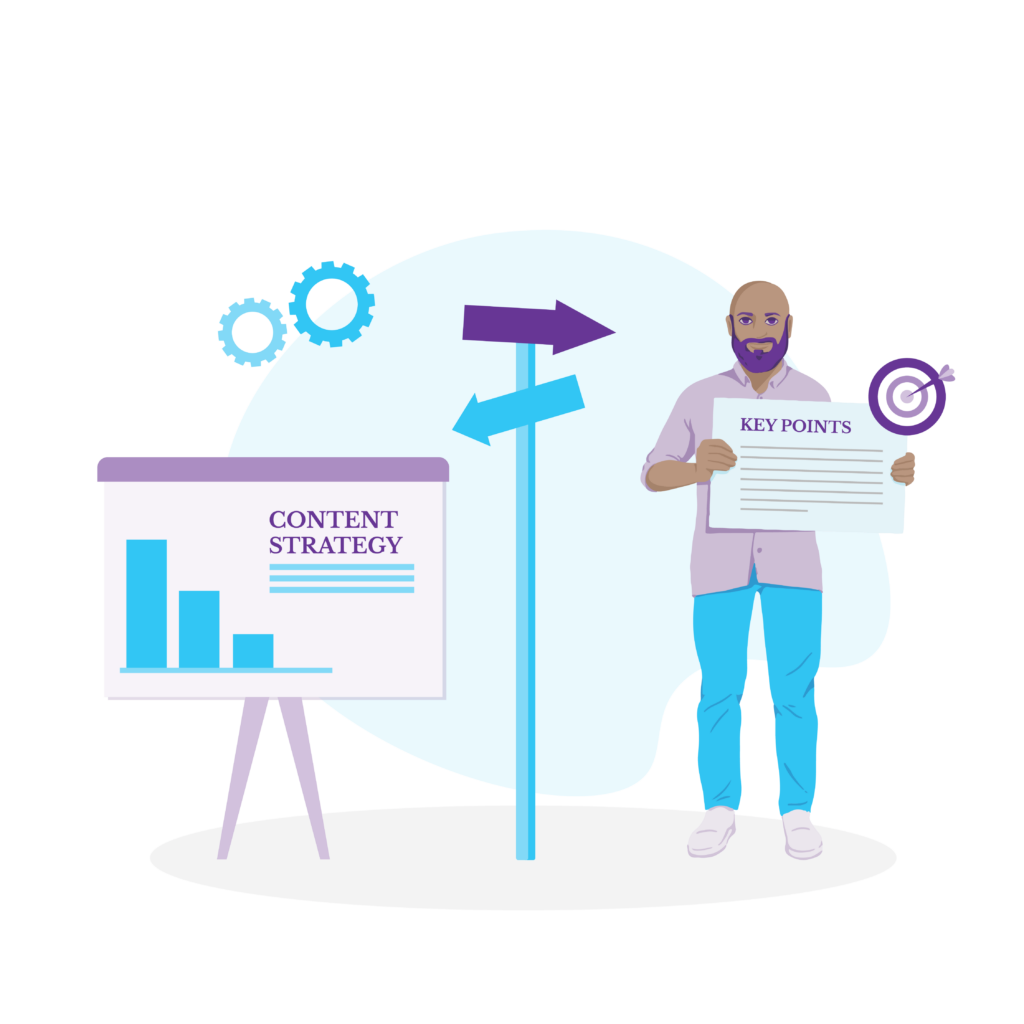Achieve your business and marketing goals with a robust, effective content marketing strategy
Having a good content strategy will improve the return you get on your content and content marketing investments, whether those investments are in the form of time, resources, money or a combination of the three. And in some cases, following a content marketing strategy can even mean the difference between business success and failure, especially for smaller businesses with a lower marketing and advertising budget. So taking the time to get your content strategy right is something that will really make a big difference to your business.
This guide covers everything you need to get yourself a stellar content strategy that will help you achieve your business goals while also reducing your marketing costs. If you want to win more sales and generate consistent business growth in a cost-effective manner, read this article or listen to the audio.
Topics covered
Content strategy definitions

Before you jump into learning how to create a content strategy, take a minute digest these definitions. You won’t get the most out of this guide if you’re working off a different understanding of the key terms.
But if you’re sure you know what the below key terms mean, then you can skip the definitions section.

What is content?
Content is information designed to be delivered to an end-user. Technically, everything you see on the internet is content, but when someone uses the term ‘content’, they’re usually excluding ‘copy’, where copy is any text designed to convince readers to take an action.
The product description is a well-known example of one type of copy that’s designed to convince readers to buy a product or service. The button is a well-known example of a type of ‘micro-copy’ that can be used to elicit a variety of actions. For instance, a ‘buy now’ button aims to make a sale, but a ‘read more’ button aims to convince more readers to click through to an additional piece of written content.
The tricky part of this definition is that copy is a sub-category of content. So all copy is content, but not all content is copy. However, most experts refer to the two terms as if copy were a separate beast because it makes descriptions a little less complicated. Throughout kmwade.com, whenever we use the term ‘content’, we try to always be clear about whether we’re talking about content as a whole or non-sales content. If you’re ever confused, just ask!
What are the types of content?

Because content is anything that conveys information to an end-user, there are a great many types of content. Here are the five top-level categories and some examples of types of content that falls into those categories:
- Written content e.g. blog posts, brochures, articles, case studies, whitepapers, eBooks, social media posts
- Interactive content e.g. templates, checklists, surveys, live webinars, games, apps, augmented reality and virtual reality content
- Visual content e.g. photos, illustrations, infographics, videos
- Audio content e.g. podcasts, sound bites, recordings, music
- Copy e.g. buttons, product descriptions, SEO title and meta description, landing pages, website sales pages (e.g. your homepage), flyers, invitations, ads
And as you can probably guess, many types of content can fall under two or more categories. For instance, most videos will include some kind of audio and some will include text. As another example, social media posts can include any combination of text, images and videos and some platforms also allow polls and other kinds of interactive content.
What is content marketing?

Content marketing is an inbound marketing tactic that attracts a brand’s ideal audience by solving their problems without explicitly promoting the brand. Content marketing relies on consistently creating, distributing, promoting and sharing valuable and relevant content that attracts and nurtures the ideal audience, directing that audience to persuasive copy and then providing yet more informational content.
The aim of content marketing is to:
- attract the kinds of people who will buy the brand’s products (or sign their petitions, or donate to their fund etc.)
- prove the brand can effectively solve the problems those people face
- direct them to copy that will convince them to make a purchase (or sign their name, or make a donation etc.)
- and then give them more information that will help them make the most of the product or service they’ve bought (or keep up to date on the progress of the cause, or feel good about having helped someone with their donation) so they’re happy and are more likely to keep going back to the brand and spread the word about the brand and what it offers
As with all marketing, the ultimate goal of content marketing is to generate more profits (or secure more signatures or donations etc.). The key differences are that content marketing aims to do that by better serving the needs of the target market and encouraging them to go to the brand rather than the brand having to consistently reach out to the target market.
What are the types of content marketing?

If you google ‘what are the types of content marketing?’, most results talk about the different types of content instead of the different types of content marketing. Possibly, the reason for this is that there are only really two types of content marketing: online and offline.
Online content marketing revolves around digital content delivered via the internet. Offline content marketing is all about content you can hold, like brochures and newspaper articles, delivered into a customer’s hands.
There is some crossover between the two. For instance, radio content can be listened to via a traditional radio or online via a digital radio. Similarly, QR codes can be used to make it easy to deliver a physical piece of content and direct people to another online piece of content.
What are the benefits of content marketing?

If you practice content marketing correctly, you’ll experience these valuable benefits:
- Increased visibility of your brand, for example in search results, on social media, on the radio, in the newspaper
- Increased awareness and recognition of your brand
- Better relationships and communication with your audience
- More credibility and authority in the eyes of your audience
- Your audience will perceive you as an expert in your industry
- Customers and clients will be more loyal to your brand and will advocate for you with their networks
- Increased traffic to your website, physical shop, social media profiles and other places your audience can find you
- Faster movement of your target market through your sales funnel (so they go from prospect to loyal customer more quickly)
- What is content strategy?
Terms confused with content marketing
There are four closely related documents that all sometimes get referred to as ‘content strategy’:
- Content marketing strategy
- Content strategy
- Content plan
- Integrated content strategy
Here’s an overview of what each of these documents is so you can see what the differences are and how they fit together.

What is a content marketing strategy?
Your content marketing strategy lays out why you’re creating content, who your audience is (who you’re helping), and how you’ll help that audience in a unique way (why your audience can’t get that help elsewhere). It also describes your overall content marketing goal. Usually, this will be something like increased revenue, lowered expenses or customers that are a better fit for your brand.
What is a content strategy?
Your content strategy is the next level down from your content marketing strategy. This document covers the creation, publication, promotion and maintenance of your content.
What is a content plan?
Your content plan is the next level again, and it’s your tactical document that describes how you’re going to execute your strategies. It includes who will create your content, content topics, a content calendar and even specific call-to-actions that you’ll include in your content.
What is an integrated content strategy?
An integrated content strategy is like a master document that collates your content marketing strategy, content strategy and content plan.
What is a content strategy framework?
You might also come across the term ‘content strategy framework’. This is often part of an integrated content strategy (though not everyone uses that term) and it combines the content marketing strategy and the content strategy.
Why have a content strategy? Why have a content marketing strategy?

Every business has broad, top-level business goals. Usually, these are some measurable version of ‘increase profits’. (Other types of organisations have equivalent goals.)
Once you have business goals, you can develop a strategy for achieving those goals. That’s your business strategy. And it’s pretty much certain that your business strategy would include some form for marketing.
Good businesses then have a set of marketing goals which break down the big business goals into smaller, more manageable pieces. These could include SMART versions of things like ‘increase foot traffic’, ‘increase website traffic’, ‘increase the quality of our leads’, ‘increase our conversion rate’ and ‘increase the average lifetime value of our customers’.
Once you have marketing goals, you can develop a strategy for achieving those second-tier goals. That’s your marketing strategy. While content is not a given in all marketing strategies, some form of content does feature in the majority of marketing strategies, even if the only content is a basic website. So it’s a fairly safe bet that your business’s marketing strategy is going to include at least a mention of content, regardless of whether you choose to use content marketing.
Great businesses develop a third tier of more granular goals for the different types of marketing they’re going to use. For those using content marketing, that means having specific content goals. Even businesses that aren’t using content marketing would still benefit from goals for their website. These third-tier goals can be related to things like dwell time, bounce rate, engagement, click-through rate, and a whole lot more depending on what the marketing goals are.
By now, you’ve probably spotted a pattern, but I’ll spell it out anyway. If you’ve got a set of content goals, you can develop a strategy for achieving those goals. And if you’ve got a set of content marketing goals, you can develop a strategy for achieving those goals too.
If your business has all these levels of goals, you have something to aim for at each level — you know where the centre of the target is. Once you know that, you can figure out things like who you’re going to target in order to achieve your goals and how you’re going to help them solve their problems. You can figure out what marketing assets you’re going to need, where you’re going to get them from, where you’re going to deploy them and what you’re going to do to promote them.
If you don’t know those things, it’s like going hiking without a map. You know where you want to get to, and you’ll probably know which direction to head, but you’ll have no idea what paths to follow.
This is why you should have a content marketing strategy (if you’re going to use content marketing) and a content strategy (if you have any kind of content, even if it’s just a website).
Continuing with the hiking analogy, a content plan is the equivalent of a plan that tells you when you’re going to start your hike, what you’re going to wear, what you’re going to pack in your backpack, who you’re going to travel with and all the other things you need to know if you want to get to your destination safely. Sure you could just wing it and things might turn out ok. But they might not.
What happens if there’s a storm? A fire? Someone gets injured? You misread the map and get lost?
Even if nothing goes wrong, there are still things you need to plan for. For example, you need to know roughly how long it’s going to take to get to your destination so you know how much food to take. And you’ll need to know where you can fill up your water bottles.
A good hiking plan enables you to head toward your destination and deal with all the normal hiking challenges that everyone faces, like food and water, as well as unexpected ones, like natural disasters or an injury. If all goes well, you’ll get to your destination. If there’s a major problem, you might only get partway and you might need to be extracted, but you’ll have the resources you need, like a satellite phone to use to call for emergency services, to come out the other end alive.
A good content plan does the same thing. It enables you to work towards your content and content marketing goals in the face of normal challenges as well as unexpected challenges.
For example, businesses that had a good content marketing strategy and a great content strategy, as well as a great content plan, were able to adapt to COVID-19 lockdowns much more quickly and successfully. Sure they might not have accomplished their original goals, but they will have made progress towards those goals. And they’re still alive today.
Many of the businesses that didn’t have those documents, have closed for good.
What is a good content strategy? What is a good content marketing strategy?

A good strategy allows all goals to be achieved if there aren’t any external forces that hamper efforts. If there are such challenges, a good strategy keeps things alive or afloat.
It’s that simple.
A good business strategy enables businesses to meet their business goals, or at least stay in business if there’s a disaster.
A good content marketing strategy enables businesses to achieve their content marketing goals, or at least make progress towards them if there’s a disaster.
A good content strategy enables businesses to achieve their content goals, or at least move towards them if there’s a disaster. And unless you’re only creating offline content, you’ll get the best results if your content strategy also includes elements of SEO strategy so you get good search visibility and search traffic.
What will make a good content or content marketing strategy for your business will depend on your goals, your current position, your resources and whole bunch of other factors. But here are some examples of successful content strategies to inspire your own
Examples of effective content strategies

- The quintessential content strategy
- More, better-qualified leads
- More leads, more conversions
- Staff empowerment
- Consistency
- Flexible strategy
- A central content marketing strategy
- Demonstrate subject matter expertise and drive organic search
- Helping others
- Guerrilla marketing
- Increased sales
- Sold out products
- A new brand competing with well-recognised brands
- Filling the gaps
The quintessential content strategy
Being the first example for this guide, it’s fitting that Megan’s example of a successful content strategy showcases the standard items good content strategies include:
- Customer research, competitor research and market research
- A SWOT analysis (an analysis of the strengths and weaknesses of, opportunities for, and threats to the brand in terms of content)
- Proposed major content themes tied to their brand
- Bottom of funnel, middle of funnel, and top of funnel topics
- A forecast of traffic and leads for the year and the necessary budget
The goals for this content strategy were also pretty typical. The brand wanted to drive more leads to their website and convert more of them into paying customers.
By developing a standard content strategy, Marketing Overalls was able to deliver a great result for their client: 100% growth year over year, more than 1 million additional sessions and triple the number of leads.
“The strategy drove more leads, and as a result, more revenue. It also created more brand awareness, as it provided content that could be used across every other marketing channel (in emails, on social media, etc).”
Megan M.
Megan was the marketer wearing overalls behind Marketing Overalls, with 10 years of experience leading acquisition and retention at successful startups.
More, better-qualified leads
Jase Rodley’s primary content strategy goal was to get every page on his website showing up in the first three positions in the search results for their primary keyword, and on the first page of the search results for their secondary keywords. His content marketing strategy goal was to generate business leads.
His plan included a spreadsheet that outlined the primary and secondary keywords for every page and blog post on his site. He also put together a content guide for his writer that covered things like how to research the topics, what the structure should be, and his style and formatting requirements.
Imagine getting leads saying “Thank you so much, your website is so helpful. What are your prices and when can we start?”. This is a near-daily occurrence.
Jase Rodley
Most small business owners, like myself, don’t have time to be drumming up leads, so this is massively valuable from my point of view!
Despite his website being in a low-volume niche, Jase’s site generates around 150 leads per month. And more importantly, those people already trust his brand.
Here’s what Jase had to say about his strategy.
My strategy worked in a few core ways:
Jase Rodley
1. It gave my writer very clear focus when writing an article. Often writers are given very vague briefs, but using this format they clearly knew the topic and sub-topics of each page or blog post. Writers love when there are few or no revisions, so I saved both them and myself time.
2. It prevented “keyword cannibalisation” — when 2 pages or posts on the same website compete against each other before they can compete against other websites. This helped our content to rank better.
3. It saved money! Similarly, when there are multiple pages or blog posts on the same topic, that’s just wasted money as only one of them will rank on page 1 of Google nowadays.
4. By covering all suitable topics for the site’s niche, we essentially created a “mini Wikipedia”. When people discover the site, they often read 5+ articles, instead of having to leave and read them elsewhere.
Jase Rodley is obsessed with all things SEO and content marketing. When he’s not building websites, running SEO campaigns or blogging, Jase enjoys bush walks or riding his bike in the mountains.
More leads, more conversions
While Jace’s content strategy attracted a greater number of more relevant leads, Adriana’s strategy aimed to attract more leads for her client and convert more of those leads into paying customers. She aimed to increase both by at least 10% but exceeded expectations when her strategy generated 50% more leads and a conversion rate of 25% higher than the starting rate.
How did she achieve this?
“The content strategy covered: in-depth market/buyer persona/competition research, editorial plan, content alignment to business goals, tone of voice used, content types to be produced, measurement and reporting tools.”
Adriana Tica, Copywritech
This example of a successful content strategy highlights the need for measurement and reporting when developing any kind of strategy, including content strategy.
Adriana Tica is an expert marketer and copywriter, with 10 years in the field, most of which were spent marketing tech companies. She is the Owner and Founder of Idunn. In October 2019, she also launched Copywritech, a digital marketing agency that provides copywriting, SEO content writing, and strategy services to companies in the tech industry.
Staff empowerment
Often, we focus on sales-related goals when we’re thinking about marketing strategies, so I love that Mark Webster and his business partner took a different tack.
Their goal was to empower their writers to be more independent so they could produce great content with less oversight. This meant coming up with a clear research process, specifying obvious goals and providing extra tools for competitor analysis.
As a result of their efforts, Authority Hacker has been able to double, almost triple, their content output. Already, 2020 is set to be their most successful year in terms of content output as well as engagement and traffic. And at the same time, the co-founders have more time to devote to business development.
“It goes without saying we’ve achieved extra rankings and organic traffic which has had a clear upfront impact on the business, however, it’s also given us much more free time to focus on our paid products and build them out. We haven’t had this much free time ourselves in a long time!”
Mark Webster

Mark Webster is Co-founder of Authority Hacker, an industry-leading online marketing education company. Through their video training courses, blog and weekly podcast, they educate beginner and expert marketers alike. Many of their 6,000+ students have taken their existing businesses to the forefront of their industries or had multi-million dollar exits.
Consistency
Matthew’s content strategy revolves around regularly and consistently posting videos, articles and valuable social posts.
“The problem with hiding my best content behind a paywall means that no one can see it — and if they can’t see it, then they are hesitant and reluctant to purchase.”
Matthew
Matthew’s offering is pre-recorded saxophone lessons. Like a growing number of online businesses, he sells video content. And as he so astutely points out, when content is your product, the challenge is proving your content is valuable without giving it all away for free.
Matthew takes a good approach to overcoming this issue. He takes snippets of his main members videos and publishes them in as many places as he realistically can, with an emphasis on his YouTube channel and Facebook page.
“This allows potential customers to see my product(s) and get a feel for what they can expect when they join, while not ‘giving away the farm’.”
Matthew
His main goal is awareness.
“If no-one knows that I or my offering exists, then it makes no difference how good my product is!”
Matthew
By leaving multiple breadcrumbs in several places that his target audience is likely to be hanging out, he has a much better chance of getting in front of the right people at the right time. And search engines like that approach too.
Matthew’s other related goal goes to the very heart of content marketing — helping people achieve their goals.
“By giving away a part of my total content for free then my audience win because they find an immediate solution to their current problem and I win because if my audience members want more then they now know where to find me!!
Matthew
Regular and consistent content creation and sharing is, therefore, a vital component of my overall strategy.
Having paying customers is the ultimate goal – I enjoy feeding my family and turning on the lights when it gets dark!
Helping people achieve their goals help me, in turn, to achieve my goals.
More views, more breadcrumbs, more eyeballs on my content that all lead back to my website allows this to happen.
And it’s very inspiring and humbling that I am teaching saxophone to virtual students all over the world.
Hearing about people achieving great things on their saxophone lessons journey, such as surprising their partner at their wedding by busting out their sax, or playing their favourite song at their first gig with their friends in a band, at a pub, or church, or community group, or simply being able to play ‘Happy Birthday’ to their children or grandchildren is just wonderful!”
Matthew helps beginner saxophone players of all ages learn how to play their favourite rock, soul, funk and blues songs without reading music – quickly and easily – with his online saxophone lessons membership.
Flexible strategy
Often we people are first introduced to content strategy, they get the sense that a strategy and plan have to be really rigid. But Paige’s success story demonstrates that a flexible, rolling type strategy can be equally effective. As always, marketing is about what works best for your brand.
Paige’s continuous goals are to build her brand, increase her visibility and raise her profile in order to allow her to attract more clients and customers. So far, she’s had articles published on Medium, Thrive Global and other leading websites, which have all had great exposure — exactly as planned.
This has driven traffic to her site, lots of social media interest, particularly on Twitter and LinkedIn, and led to several podcast invitations and media requests, which have been great for her exposure and credibility.
Here’s how Paige describes her content strategy.
“Our content strategy is to leverage Content Marketing as a gateway to Thought Leadership by regularly sharing quality content based on my experience personally and professionally. To qualify it must be timely and relevant.
Paige Arnof-Fenn
To generate ideas I look at the calendar to see if there are any natural opportunities based on the season or activities, keep a running list of topics I get asked about by my clients and other business owners and note when I read or hear about something new I want to explore further, a trend, theme or idea that catches my attention.
If it is an issue that affects me or my business then it is likely to be a topic that impacts others too.
Once I decide on an idea to write about I may do research on the topic, talk to people for input and just start typing. If I have a unique perspective to share or any advice I think may help others, I get it out there via social media or whatever distribution vehicle makes the most sense.
To make content more attractive and drive conversion it is important to understand not just what or how to purchase a product, experience or service but you must also be able to inspire audiences by identifying the underlying motivation. The key to becoming influential is when you can answer why they do what they do and connect with people on an emotional level.
These ideas do not require big budgets but they do take time. It is a smart investment to get this right and has helped me grow my business.”
Paige Arnof-Fenn is the founder & CEO of global marketing and branding firm Mavens & Moguls based in Cambridge, MA. Her clients include Microsoft, Virgin, The New York Times Company, Colgate, venture-backed startups as well as non-profit organizations. She graduated from Stanford University and Harvard Business School. Paige is a popular speaker and columnist who has written for Entrepreneur and Forbes.
A central content marketing strategy
Venngage epitomises the power of content marketing. It’s a technology startup that relies almost solely on content marketing to drive sales, so much so, that it doesn’t even have a sales team.
“The majority of our users found us through the content we create like blog posts, videos, social media content, or webinars and infographics.”
Alice Corner
Obviously, a brand that relies so heavily on content is going to have a big content strategy so I can’t detail the whole thing here. But I am going to highlight one part of the Venngage content strategy that love.
Venngage staff call it ‘guestographics’. And the brand has increased its revenue and traffic by almost 400% in one year just from this single part of its content strategy.
A guestographic is the same as an infographic except that you create it for another brand. It’s like guest posting, but instead of creating a guest blog post, you’re creating a guest infographic. And instead of creating a blog post about something you’re an expert in, you create an infographic that summarises the other brand’s information.
Venngage created free guestographics as a means of reaching important influencers with an offer they ‘couldn’t refuse’. The result was that they increased awareness of their brand, showcased their offering and generated quality backlinks.
Alice Corner is a B2B Content Marketer with 8 years experience specialising in creative content that clients and audiences love.
Demonstrate subject matter expertise and drive organic search
One of the most important benefits of content marketing is that it enables brands to demonstrate their industry authority and expertise. This builds trust and helps brands prove they can solve relevant problems. And this, in turn, improves search rankings, traffic and conversions.
StoryAmplify shared an excellent example of how content marketing can do this so effectively.
The team developed a content strategy for Realized’s blog, which aimed to demonstrate Realized’s subject matter expertise and drive organic search traffic to their site.
Since November 2018, the brand increased its blog post publishing frequency from one to five articles per week, and this strategy has delivered 100% organic search traffic growth, which is equal to an extra 30,000 visitors each month.
Our paid SEM CPC is $2. And an extra 30K visitors a month makes 360k annually. Multiply the two and you get a $720k annual saving by not having to rely on paid search advertising.
Trey Robinson

Trey Robinson is Chief Marketing Officer & Business Consultant at StoryAmplify, which is a content marketing, SEO, and inbound shop that specializes in growing traffic, leads, and revenue for businesses of all types and sizes. With a specific concentration in Financial Services and subscription businesses, SA has a proven track record of success.
Helping others
One of my favourite examples of a successful content strategy is from Jess of Crow Creek Designs because her strategy is all about helping other people. This really resonated with me because my mission, in a nutshell, is to build a better tomorrow by helping other organisations solve crucial problems for more people.
I do this by helping organisations with strategic marketing assets for their entire sales funnel. Jess does this by helping people find a sense of accomplishment.
Here’s what Jess had to say about her content strategy.
“I have created my own content strategy based around using your hands to build (more than) furniture and art– the goal is to “build” confidence and inner strength. To help others, particularly women and at-risk-youth, find a sense of accomplishment through building; a traditionally male-dominated field can be tricky to navigate. By documenting my own personal growth, including setbacks and failures, I have been able to achieve my goals of encouraging and teaching others through open and honest conversations.”
Jess Crow
And Jess’s strategy has certainly helped her achieve some amazing things. She’s become one of the most recognised teachers in her field and was the first in her field to have a white label line (an epoxy resin) created in her name with a national company (TotalBoat epoxies). She’s also been featured in numerous publications like INSIDER, DIY Network and Thrive Global. She even won Duluth Trading Company’s national ‘Women Who Do’ contest and was published as a model for the brand.
Jess Crow owns and operates an artistic woodworking shop in Alaska called Crow Creek Designs.
Guerrilla marketing
“As a tech data startup, we’ve learnt to produce content using our own product. We predict customer demographics using names so we conducted case studies from analyzing social media demographics to measuring gender and race bias in movies. Additionally, we compared our results with reputable sources such as Google and Pew Research. We literally became our first ‘clients’.”
Kirill Rebrov
Demografy offered a very interesting content strategy. You see, it’s pretty common for technology startups to arise when the founders can’t find a solution they need and decide to make it themselves and then offer it to others in the same situation. But what’s not so common, is using your new solution to market your business in the way Kirill and his team have done.
Their initial content strategy revolved around producing case studies built using their own product and publishing them on their blog and Medium. Their goal was to validate their business premise and get initial traction during the pre-launch phase of their business by attracting early adopters for their waiting list. By using their own product to produce the content, they developed content that is valuable to their target market and which served as proof that their technology worked at a time when they hadn’t secured any users yet and so didn’t have any social proof.
“So we used these case studies as our blog content during the pre-launch phase and this ended up as the best fit for BoFu (bottom of the funnel) content. It produced both content worth of reading (unique insights and analytics) and a kind of proof and showcase of our technology to potential clients.
Kirill Rebrov
Additionally, guest posting in already promoted publications allowed us to reach a wider audience. It’s hard to get big outreach for a newly established company so we believe guest posting was a key factor in higher reach. The only trick with third-party publications is to get approval for posting. But having unique data and analytics as content makes it much easier to be approved as well.”
The team’s top two performing blog posts had an overall conversion rate of 4.4% from article read to lead. And the first eight articles they produced delivered 11.6% on-site conversion (from site visit to lead on their waiting list), 2.7% total conversion rate (from article read to lead on their waiting lists), and three waiting list signups from major brands.
Kirill is keen to point out that these results aren’t super impressive in terms of absolute numbers, but when you consider that this was for a brand that was starting from scratch, before they’d even launched their product, it’s pretty decent.

Kirill Rebrov is CEO/CTO and co-founder of Demografy, Florida-based customer segmentation noninvasive AI startup that uses machine learning to predict demographics from masked names. Kirill’s 12+ years background in software development as developer and tech lead helped build patent-pending technology behind Demografy. He and his team see Demografy’s mission in redefining the data marketing industry which is currently based on non-opt-in consumer data use and private data reselling.
Increased sales
Amy succeeded in achieving the difficult goal of increasing consumer sales during the COVID-19 pandemic. And not only did she increase consumer sales, but she did so by an amazing 40%.
Her strategy was to create consumer content and offer free shipping to help with the financial burdens facing many US consumers. Amy’s content plan included:
- Communicating shipping discounts to consumers via the primary grossing consumer channels, Facebook and Instagram
- Duplicating the top-performing consumer ads from the last 6 months and adding the shipping discounts
- Retargeting all website visitors in the USA with ads showing the shipping discounts
- Retargeting new visitors with a combination of the product ‘how it works’ ad combined with the discount
Amy Houck is the Digital Media Director at Pascale Communications. With her 13 years of digital marketing experience, and expertise in paid media, she leads the Pascale team to drive maximum results for clients.
Sold out products
Jeff and his team wanted to increase brand awareness, demonstrate their expertise and increase sales. So they developed a content strategy with a little help from an external consultant.
Their strategy covered things like SEO keywords and searcher intent, content types, and publication and promotion platforms. And it worked exceptionally well.
The first time they implemented their strategy, the team generated over 4,500,000 views of a single video, many high-quality backlinks and they sold almost every item they had in stock within a couple of weeks. They’ve gone viral again a few times since then as well.
While they’ve never quite had the same success as that first time, it’s clear their content strategy has been an invaluable marketing tool. And yet the way their strategy helps them achieve their goals is deceptively basic.
“The strategy made it easy to make sure we were doing everything necessary before publishing our content. It made us accountable at each step if we wanted this to be successful.”
Jeff Moriarty
If you’ve put off creating a content strategy because it seems like too much work, this is a great example of how even a very simple, straightforward strategy can yield excellent results. Yes, it’s going to take time to prepare, but the rewards are worth it.
Jeff Moriarty is the Marketing Manager at Moriarty’s Gem Art.
A new brand competing with well-recognised brands
The team at Electric Enjin had great success producing the first content strategy for a 2-year-old eCommerce lifestyle brand. Here’s what they achieved:
- Organic traffic increased by 273%
- Ecommerce conversion rate increased from 1% to 5%
- Overall bounce rate decreased from 80% to 4%
- Organic bounce rate decreased from 48% to 2.3%
- Revenue increased by 226%
- Average order size increased by 15%
- Facebook Ad conversion rate increased from 3.7% to 7.9%
- Google Shopping conversion rate increased from 0.4% to 3.8%
- Keywords increased by 450%
- Page 1 terms increased by 4,250%
How did they manage all this? With blog posts, infographics and live-action and animated video — and a strategy to make sure everything had a strategic purpose and was on-brand. They also implemented a great search engine optimisation strategy that aimed to increase organic visibility and traffic, organic transactions, and referral traffic and backlinks.
“The content strategy solved a large issue that the client was experiencing, which was that a lot of people didn’t really understand the benefits of their product so they were just going with the competitors.”
Morgan Hennessey — Manager, Search Marketing — Electric Enjin
This just goes to show how valuable it can be to have a third party take a step back and identify the crux of a brand’s issues. Often brands get ‘too close’ to their products and services and there’s immense value in having someone else come in and guide content creation to produce valuable content that quickly gets to the heart of the value of the offerings.
Morgan leads all search programs at Electric Enjin. She’s focused on getting your website found with unique content strategies and killer SEO and PPC campaigns. By diving deep into web analytics, she develops data-driven plans that will generate the most ROI for your digital marketing plan. Morgan is Google Ads and Google Analytics certified.
Filling the gaps
“The strategy was simple, create content geared towards consumers ready to convert on a call to action. However, rather than creating content which would reach a large swath of the population, we targeted small, less populated cities across America.”
Robert Moses
Robert’s strategy is an excellent example of how small businesses and startups can get massive traction in the market, even when there are lots of well-established brands doing very well. By creating hyper-targeted content for several ideal audiences, Robert was able to reach a decent number of prospects and achieve great conversion rates.
Instead of directly competing with the big players, he targeted the gaps to great success.
Robert Moses is the Founder and Chief Editor of The Corporate Con/noisseur. He is a graduate from Rutgers University and entered the corporate world for major publishing companies in New York City. He noticed a need for information on corporate life, resume advice, and career etiquette. Robert founded The Corporate Con/noisseur in 2018 and has hired an additional twelve team members to assist with content creation and marketing.
How do you create a content strategy?
So now you’re inspired to get strategic with your content marketing, how do you create a content strategy? Obviously, the exact process you follow will be unique to your brand, but here are the general steps you need to follow.

Here are the 13 things you need to create a content strategy that really works and a content plan that enables you to successfully implement your new strategy.
If you want templates and checklists to help you accomplish these steps, check out our free content strategy kit. You don’t even need to provide your contact details to access it.
Part 1. Conduct a business SWOT analysis, set SMART business goals and develop a business strategy

Conduct a business SWOT analysis
As an example, a business SWOT might reveal you’re great at generating new ideas (strength), you don’t have well-developed accounting skills (weakness), there is an opportunity for you to develop a new product to address a trending demand in your area (opportunity) and that there’s a new piece of legislation on the cards that will, if passed, increase your overhead expenses (threat).
Set SMART business goals
Once you’ve done a SWOT analysis, you can develop SMART business goals to help you capitalise on your business strengths and opportunities and mitigate, compensate for or overcome your business weaknesses and threats. An example of a SMART business goal is ‘increase profits by 30% by the end of the financial year by introducing a new, yet complementary service that caters to the growing demand for babysitting services in our area’. Another example is ‘within one month, I will set up an eBay shop so I can sell handmade earrings — within eight weeks I will have an inventory of 40 pairs of earrings to sell and I will aim to sell a minimum of four pairs per week via local networking’.
Develop a business strategy
Once you have one or more business goals, you can then look at how you’re going to achieve your goals. This should include some kind of marketing, whether or not it includes content marketing specifically, and a branding strategy.
Part 2. Conduct a marketing SWOT analysis, set SMART marketing goals and develop a marketing strategy
Conduct a marketing SWOT analysis
Your next step is to do a SWOT analysis of your marketing situation. With the learnings from that in mind, you can develop SMART marketing goals that contribute to your business goals.
Set SMART marketing goals
SMART marketing goals might look something like ‘increase accommodation bookings by 5% for young families during the next six months by adding our business to the national booking platform, bookingsrs.com, starting a blog and running targeted Facebook ads with a $100/month budget’.
Develop a marketing strategy
Once you have your set of goals, develop a broad marketing strategy. I recommend you then develop sub-strategies for each type of marketing you’re going to use.
Part 3. Conduct a content marketing SWOT analysis, set SMART content marketing goals and develop a content marketing strategy
Conduct a content marketing SWOT analysis
If you’re going to use content marketing to achieve some of your goals, your next step is to conduct a SWOT analysis of your content marketing situation. You might consider things like your knowledge of content marketing tactics, capacity to produce, promote and update content, ideal customers’ appetite for content, competitor’s use of content marketing and more.
Set SMART content marketing goals
Once you’ve got some marketing goals, and have completed your content marketing SWOT analysis, you can get more specific about how content marketing is going to contribute to your overall marketing goals and how you’ll capitalise on your strengths and opportunities and mitigate your weaknesses and threats. Examples of linked SMART content marketing goals that contribute to the above marketing goal are ‘increase the number of website visits from the parents of young families by 10% during the next six months by starting a blog and posting one post per fortnight’ and ‘achieve a blog to accommodation booking conversion rate of 1% within the next six months by publishing valuable content that includes effective call-to-actions’.
Develop a content marketing strategy
From those goals, you can then develop a strategy for achieving success. To get an idea of how you might go about doing that, break down the above example goals.
In this scenario, your target audience would be young families who want to go on a holiday. Your content marketing strategy would likely include research about this target market and would probably include a customer persona.
You’d be creating content because you’d want to attract that audience to your website and provide them with information that would solve their problems and in the process, demonstrate that you understand them and therefore that you’re more likely to provide accommodation that suits their needs. You’d also be hoping that publishing blog content would enable you to reach a wider audience and increase awareness of your brand.
You’d then have to think about how you could make your blog unique. To do that, maybe you could target young families in a particular geographic that is underserved by competitors. Or maybe you could target families with specific interests that no one else is targeting and which align with your business. Your content marketing strategy might also include an extra SWOT analysis that focuses on your business’s point of difference.
Your content marketing strategy would likely include an analysis of the kinds of content your competitors are producing and how successful each kind is. It would also probably identify any gaps that you could fill.
Part 4. Conduct a content SWOT analysis, set SMART content goals, develop a content strategy, construct a content plan
Conduct a content SWOT analysis
Regardless of whether you’re going to use content marketing, your next step is to conduct a SWOT analysis of your content situation. You might consider things like how much content you already have, whether you and/or members of your team have content creation skills and expertise, whether you have good systems in place for managing content, the kinds of content your competitors are producing, the kids of content your ideal customers like to consume, market trends and more.
Set SMART content goals
If you’re not using content marketing, but you are using content, such as your website, this is the point when you specify SMART content goals for that content which relate to your broader marketing goals. So for a website, you might choose something like ‘increase website visitors by 30% over the next six months by fixing crawl issues and optimising our SEO particulars’ and ‘increase the number of phone enquiries from our website by 10% over the next six months by hiring a copywriter to upgrade our homepage and optimise our call-to-actions’. For the latter goal, you might use a separate phone number for your website so you can measure that statistic. Alternatively, you might develop an offer that requires a code that’s unique to your website. The best SMART content goals will capitalise on your content strengths and opportunities while overcoming your content weaknesses and the threats to your content.
If you are using content marketing, your SMART content goals will be linked to your content marketing goals. If you were the accommodation business in the above example, some of your SMART content goals might be ‘by the end of the month, set up a new SEO-friendly blog on our WordPress website with an SEO plugin activated and use JetPack to set up automatic social media promotion when posts are initially published’, ‘within six months of publication, each blog post should show up on the first page of Google search results for the primary SEO keyword’, ‘promote each blog post upon publication once a month for the first 12 months on Facebook and Twitter and achieve at least 30 clicks on each post each month from those platforms’, ‘split test three call-to-actions on each blog post to increase clicks to sales pages’ and ‘review and update each blog post every 12 months to keep them relevant and ranking well’. Again, you’ll get the best results if you create SMART goals that are informed by the results of your content SWOT analysis.
Develop a content strategy
Once you’ve got your SMART content goals, you can develop your content strategy. No matter what else you include in your content strategy, every content strategy you produce (except for those covering a brand new startup) should include a content audit. There is no point duplicating existing content (and there is often a lot of value in updating old content).
Similarly, unless you’re only going to produce offline content, you’ll get better results from your content strategy if you also consider how you’ll create and maintain content that is highly visible in search results and which drives lots of search traffic to your website. The best way to do this is to develop a dedicated SEO strategy that lays out the SEO techniques and tools you’ll use based on where you are in your SEO journey.
Other than that, your content strategy might include the reasons why you’ve chosen specific publication platforms and plugins. It might also include plans for syndication. For instance, you might choose to share all your blog posts on Medium to increase your reach (and you could attribute the Medium posts to your blog so you get all the SEO benefits).
Your content strategy could include research into customer content references. For instance, you might include information about the best tone of voice and language to use in your content. You might also research the best platforms for promoting your content so you reach the largest portion of your target audience.
You might also research your competitors’ content strategies to see what topics they’re covering, what keywords they’re ranking for how you can improve on their efforts.
Your content strategy will probably include major content themes. Note the specific content topics belong in your content plan, but your content strategy might include a method for selecting topics.
Including budgeting details in your content strategy is a good idea so you and anyone on your team know how much time, how many resources and what finances are going to be dedicated to creating content.
One often-overlooked part of all good content strategies is information about how you’re going to maintain your content. How will you keep on top of broken links? How often will you update your content and what will you focus on when updating content?
Another often-overlooked part of a good content strategy is the tools you’ll use. You might include details about tools for drafting text, creating images, creating and editing videos, creating and editing audio, publishing content, promoting content on social media, promoting content via email, printing content, promoting content via SMS, influencer outreach, detecting broken links, measuring content success and more.
Depending on your niche, you might also include a strategy for creating newsjacking blog posts and other content. If you include this, your strategy would need to cover things like the types of news to monitor and the decision process for choosing whether and how to produce newsjacking content.
Finally, all good content strategies should include details about how you’re going to measure the impact of the strategy and your progress towards your goals. After all, it’s all well and good to have a plan, but if you don’t know how effective it is, you won’t know how to detect or correct any issues and you won’t be able to improve upon it in future iterations.
If you want an easy way to organise all that, our free content strategy kit contains a checklist and template that you can use to pull together an awesome, effective content strategy. This content strategy kit really is free and you don’t even need to give us your email address to get it!
Develop your content plan
When you’ve done all that, don’t forget to create a content plan so you know exactly how you’re going to implement your strategy. Your plan might include things like:
- Specific content topics for each stage of your sales funnel (from attracting people who are just becoming aware of their problems or even those who aren’t yet aware, to encouraging loyalty and advocacy) and a plan for how the content on each topic will link together
- Details about who will create, publish, promote, maintain and measure the success of your content
- A set of call-to-actions and information about when and how to use them
- A content publication calendaru003cbru003e- A content promotion calendar
- An events calendar for key industry dates
- A list of SEO keywords and search queries to target
- Content templates
- A style guide
- A tone of voice guide
- Standard operating procedures
- Tagging and categorisation guidelines
- Guidelines for managing customer reviews and comments on blog posts, social media and other relevant places
- Details about how to file content (including drafts)
- Brand assets that need to be used during content creation
- Onboarding material for new content creators and managers
Now, you may be wondering why you need so many different layers of analyses, goals and strategies. There are several reasons, but the most important is that it provides flexibility to adjust to external changes.
Your business goals are top-level objectives that are unlikely to change very often, but the way you achieve them will change when your environment changes. Similarly, your strengths and weaknesses will evolve as you undergo professional development and as the composition of your team changes.
As an example, if you find your content strategy isn’t working as effectively as you’d like after a few months, you can try a different approach and easily modify your content goals and strategy. Or you might outsource some of your content creation to an expert, which would alter your SWOT analysis. And if there’s a major change in the business environment, such as the lockdowns that were imposed across the globe in response to the COVID-19 pandemic, you may be able to change your content marketing goals and strategy, and even your marketing goals and strategy, to respond to the change without having to modify your business goals and strategy.
By having several layers of SWOT analyses, goals and strategies, you can make changes at the lower levels without having to change your broader approach — you can keep working towards the same higher-level goals and just change your methods to suit conditions.
What makes a good content strategist?

If you don’t have the skills, time or resources to develop your own content marketing strategy or content strategy, bringing in outside help can make a great investment. In fact, if you’ve got a limited budget, the most effective way to use your budget might be to outsource your strategy work and then create all or most of your content in-house. But the best use of your resources will always depend on the skills you and your existing team (if you have one) already possess.
Doing a SWOT analysis of your existing skills can be a big help during this kind of decision-making process, but if you need to choose between several similar-cost arrangements, you’ll need to know how much effort and cost would be required to up-skill someone who has the qualities and some of the skills required to be an effective content strategist. And to know that, you need to know what makes a good content strategist.
You’ll also need to know what makes a good content strategist if you decide to outsource your strategy.
So bearing in mind the kinds of things that might be included in a content strategy, here are the key skills, qualities and areas of expertise that can combine to make a great content strategist:
- Copywriting and content writing skills — Some content strategists also create content, but content creation is not part of a content strategist’s role. Despite that, content strategists need to have an in-depth understanding of how to plan, design and execute all kinds of marketing campaigns and they can’t develop that kind of expertise if they can’t write themselves.
- Marketing campaign experience — Similar to the above point, strategists need to understand how to run a successful marketing campaign if they’re to develop a strategy that will guide one or more marketing campaigns.
- Research and data analysis skills — A solid content strategy has to be based on a foundation of quality, in-depth research. Therefor good content strategists need to be able to conduct detailed research and accurately interpret the resulting data.
- Project management skills — If your content strategist is going to help with the implementation of your strategy, they’ll need to be able to manage complex projects.
- A passion for what your business does and helping your target market — If your content strategist’s beliefs don’t align with what you do and they don’t care about your target market, they’re not going to be very invested in your success. Finding someone who wants you to succeed is incredibly important.
- A broad perspective and attention to detail — Good content strategists need to be able to see the big picture when it comes to your business and strategies. But at the same time, they need to be able to detect tiny details that could derail a project. The combination of these qualities is pretty difficult to learn.
- Ability to work well under pressure — There’s a huge amount of pressure for content strategies to perform well, especially for strategists that are also overseeing the implementation as well. Those who buckle under pressure won’t survive for long as content strategists.
Final content strategy thoughts

If you want your business to be able to weather storms and support you, your employees/contractors and your families for years to come, it’s vital you have layers of strategic goals to guide your operations and strategies and plans that help you realise those objectives. No matter how you’re going to reach your goals, content should be a vital part of your plan and content marketing may also play a role.
This guide highlights the value of content-related goals and strategies, details what your various content strategy documents need to cover and offers guidance about how you can go about creating your own content strategy or choosing a strategist to help you create a document that will plot an effective course to your business’s success.
